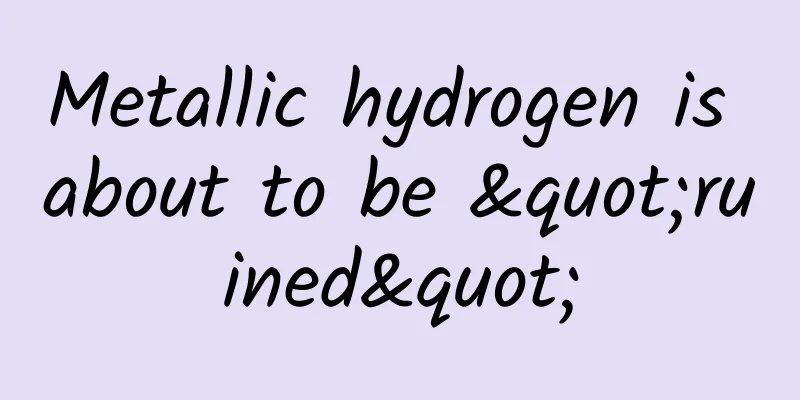Metallic hydrogen is about to be "ruined"

|
Hydrogen is the most abundant element in the universe, and it is also the first element in the periodic table, belonging to the first main group. In high school chemistry, we know that the first main group is alkali metals , such as lithium, sodium, potassium, rubidium, cesium, francium, etc., which are all very active metals. However, the hydrogen element, which is at the first position in the first main group, is a bit out of place because it exhibits non-metallic properties. But scientists believe that hydrogen, as an element of the first main group, should have the potential to have metallic properties. As early as 1935, theoretical physicist Eugene Paul Wigner predicted that as the pressure increases (to about 4 million times the atmospheric pressure on the earth's surface), solid hydrogen will begin to exhibit the properties of a conductor, which means that hydrogen can now conduct electricity . Following this prediction, scientists around the world have been trying to find metallic hydrogen, but creating pressures high enough to test the theory is extremely difficult. After more than half a century, although scientists still have not glimpsed the true appearance of metallic hydrogen, many scientific research teams in France, the United States and Germany have made great progress in compressing hydrogen and detecting the properties of hydrogen under high pressure. First appearance of metallic hydrogen It wasn't until January 2017 that Issac Silvera, a professor in the Department of Natural Sciences at Harvard University, and his postdoctoral researcher Ranga Dias announced that they had discovered the most valuable material on the planet: metallic hydrogen . The relevant paper was published in the magazine Science on January 26. In order to obtain this extremely rare material, ordinary methods are definitely not possible, so scientists invented a diamond anvil cell (DAC) method. Simply put, pressure is the ratio of the pressure exerted on an object to the area under force . When the pressure we apply reaches its limit, we can increase the pressure by reducing the area under force. If you don't understand, you can imagine whether it hurts more if a girl kicks you with a round-toed shoe or a pointed-toed shoe... Silvara and Diaz used diamond anvils. At ultra-low temperatures, they placed a small hydrogen sample on the diamond anvil surface (the tip of the diamond, about 50 microns in diameter) and set up infrared light to measure the reflectivity of hydrogen to determine whether it is metallized . By continuously applying external force, the pressure between the two diamonds eventually reached 495Gpa. Under such high pressure, they were surprised to find that the originally black solid hydrogen gradually took on a metallic luster, and the reflectivity of the sample also changed from black to high reflectivity , which is exactly the characteristic of metal. The states of sample hydrogen at different pressures: transparent, opaque and metallic However, after the study was published, some scientists raised doubts, believing that the metallic luster they discovered might not come from metallic hydrogen, but might also come from aluminum oxide, because before the experiment, Silvara's team coated the diamond surface with a layer of aluminum oxide to prevent hydrogen from diffusing into the diamond crystal structure . In the face of these doubts, the best way to fight back is of course experimental data, so Silvara's team prepared to continue observing more properties of metallic hydrogen. However, when they used a low-power laser to measure the pressure, a faint "click" was heard. This was because one of the diamonds could not withstand such high pressure and shattered into dust, which also meant that the only metallic hydrogen sample disappeared. The reappearance of metallic hydrogen Two years later, a research team led by Paul Loubeyre of the French Atomic Energy Commission announced that they had almost discovered the existence of metallic hydrogen . European Synchrotron Laboratory This research first appeared on the arXiv physics preprint, and six months later, it was officially published in the latest journal Nature. Similar to Silvara's team at Harvard University, Loubeyre and his team also used the "diamond anvil" method, but they made improvements and designed a new diamond anvil called the "ring diamond anvil". The tip of this diamond is designed to withstand higher pressure, so as to avoid the diamond being crushed by the high pressure as before. Through experiments, Loubeyre discovered the reflectivity of light by hydrogen samples at different pressures. When the pressure is 1 GPa, the sample hydrogen is transparent to both visible and infrared light; Image source: Nature When the pressure rises to 300Gpa, the sample hydrogen becomes solid and visible light can no longer pass through it. Only infrared light with lower energy than visible light can penetrate solid hydrogen. Image source: Nature As the pressure increases to 425Gpa, the reflectivity of solid hydrogen increases sharply. At this time, both visible light and infrared light are impenetrable. This also means that solid hydrogen at this time can block all light and is no longer transparent. Image source: Nature The researchers believe that the discontinuous and reversible change in optical reflectivity of solid hydrogen under extreme pressure and low temperature is strong evidence of the transformation of solid hydrogen into metallic hydrogen. However, this cannot serve as "solid evidence" of the appearance of metallic hydrogen. In fact, the researchers did not assert that what they observed was metallic hydrogen. As the title of their paper points out, what they found was evidence that "solid hydrogen may transition to metallic hydrogen." The red part in the center is probably caused by molecular changes in the diamond rather than hydrogen. Now, if we really want to prove the existence of metallic hydrogen, we only need to test the conductivity of the hydrogen sample under high pressure and low temperature. If the hydrogen sample can show a high level of conductivity, then we can basically prove the existence of metallic hydrogen. However, making conductivity measurements of hydrogen samples in this state is difficult to accomplish because it means the diamond tip needs to be connected to a tiny electrode and put in contact with a small amount of solid hydrogen , and currently it is difficult to make such a precise connection. Although Loubeyre's experiment cannot yet make a conclusive scientific statement such as "we have created metallic hydrogen", scientists in the field generally believe that this experimental result is almost decisive evidence to prove the production of metallic hydrogen. Perhaps now, metallic hydrogen can only exist in diamond anvil cells, but in another ten or even twenty years, metallic hydrogen will shine brightly under the sun . |
<<: 10 kinds of strange plants, how many do you know?
>>: Can smoking relieve loneliness? Experts: Loneliness may worsen
Recommend
Can the "dragon" and "phoenix" "combine"? The first dragon in Fujian with "bird wings" fills the gap of 30 million years!
On the 27th, it's time to kill the rooster! C...
[Practical Tips] Things about APP promotion and channel promotion!
Recently, many people have asked the following qu...
How does operations perform data analysis? 1 process, 3 uses, 3 tools!
What is data analysis ? What exactly are we talki...
Teach you how to quickly get 99 points in event planning
Writing event strategy plans is the basic skill o...
While you are eating it, it is also eating you... After reading this, do you still dare to eat it directly?
Expert of this article: Fu Shufang, Master of Foo...
Scientists discover ancient dinosaur "belly button" fossils! Where is the dinosaur belly button and what does it look like?
According to a paper published in the journal BMC...
Jiangsu College Entrance Examination Results Release Date 2020 Jiangsu College Entrance Examination Score Query
At 4:40 p.m. on July 9, with the completion of th...
What are those white spots at the roots of your hair? Will you become bald if you don't have them?
One minute, Doctor. Postures keep rising - End of...
15 Most Commonly Used Online Channels for Event Promotion (Recommended Collection)
When an operator plans a complete activity plan, ...
Marketing hotspots and advertising suggestions in August!
Chinese Valentine's Day, the start of the sch...
Which is better, vitamin C that costs 2 yuan or vitamin C that costs hundreds of yuan?
Speaking of vitamin C, many people think it is a ...
The most comprehensive guide to short video distribution on Tik Tok, Kuaishou, etc.!
In the Internet age, short videos are king. 2018 ...
You've seen a snake fly, but have you ever seen one do a somersault? 8 little-known facts about snakes
When it comes to snakes, many people think of the...









